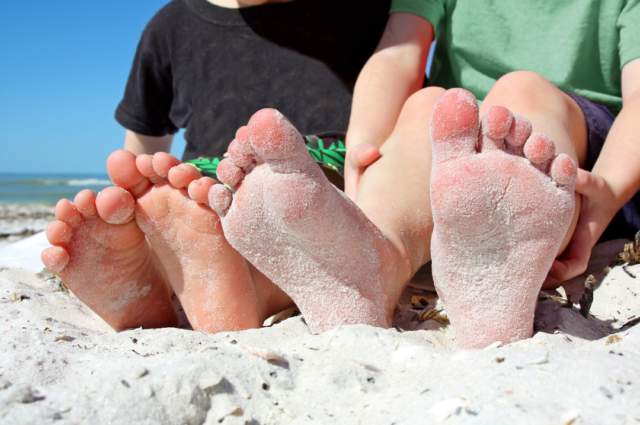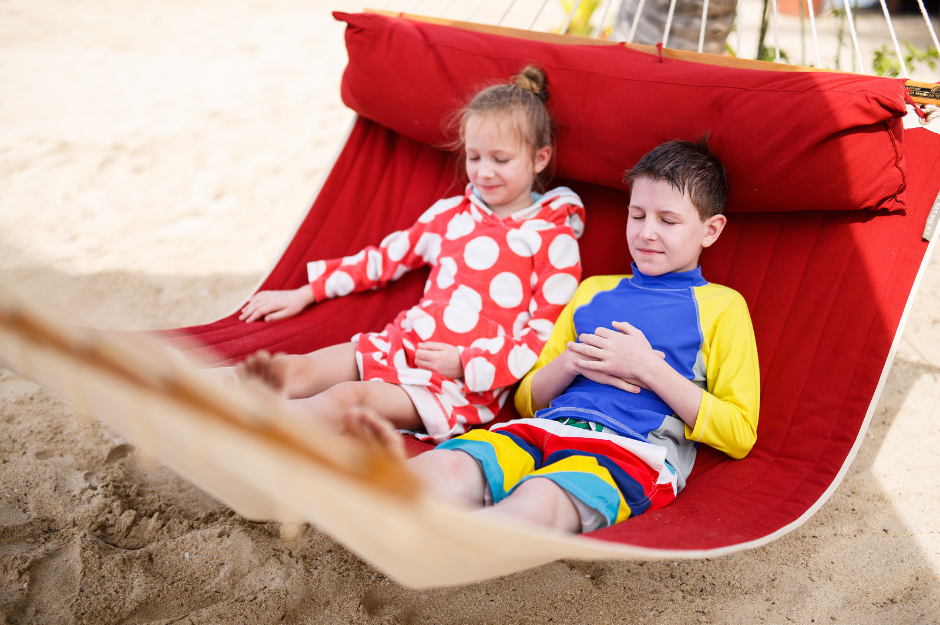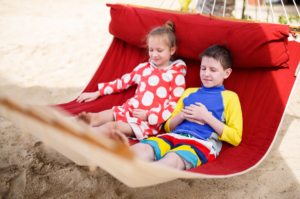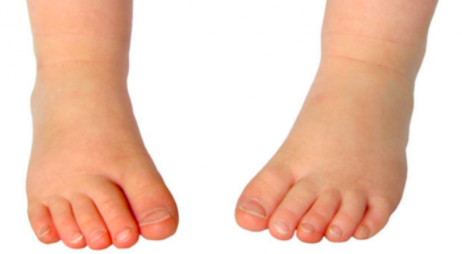
Leading children’s foot doctors in Remuera, Auckland
Our team of podiatrists work extensively with children and families to safely and effectively manage a range of foot and leg pains and problems. Aside from being qualified podiatrists, we’re parents too. So we know how it feels to see something unusual and feel concerned, worried, or wonder what repercussions the problem may have for our kids further down the track. We provide every child and family with the very best care, so you feel confident about your child’s outcome and progress.
Treatment for kids foot pain and skin problems
When it comes to children’s feet, their busy and fast-paced nature (paired with their growing and developing bones) means that there are a lot of ways the feet can be affected. We often see and treat:
- Warts on the feet: plantar warts are caused by a virus and are often spread through schools by sharing the same floors, especially when barefoot such as in swimming areas
- Growing pains: there’s a common misconception that growing pains can’t be treated and are a normal part of growth. This is far from the truth. The pain experienced in growing pains has a defined medical cause – and therefore a clear medical treatment approach.
- Ingrown toenails: ingrown toenails occur when part of the toenail grows into the surrounding skin, leading to significant pain and inflammation. This can make it very uncomfortable for kids to walk and play normally – especially in their school shoes.
- In-toeing and out-toeing: both in-toeing and out-toeing may be normal occurrences in short windows of a child’s life, but can also be pathological (problematic) and lead to problems like regular tripping and falling during physical activity
- Toe walking: for some kids, toe walking is simply a fun habit. For others, repeatedly toe walking is a sign that the Achilles tendon has contracted in length and it has now become uncomfortable for them to walk with their heel in contact with the ground
- Ankle sprains: ankle sprains are not uncommon in busy kids, especially when playing games that involve rapid changes in direction. While ankle sprains are often overlooked due to their common nature, treating them is very important in helping to prevent long-term ankle instability.
- Hammertoes: hammertoes present as toes that are bent at one or more of the toe joints, creating a prominent area that may rub against the top of shoes and create blisters, corns or calluses. While initially toe deformities may remain flexible, they tend to quickly grow rigid and fixed in place, which will persist throughout adulthood.
- Bunions: we are seeing more early bunions in children, most often linked to either footwear or genetic structural foot characteristics, both of which can be managed when a bunion is detected early, giving time for intervention to slow or pause the progression of the bunion
- Shin pain: having shin pain is disheartening for kids as it can interrupt their ability to play with their friends, adventure and explore.
- Knee pain: we see and treat knee pain in kids from a range of causes including growing pains at the knees.
- Heel pain: while growing pains are a common cause of heel pain in kids, we are seeing more and more instances of other causes, especially those seen in adults as children start to enter more competitive sports at an earlier age.
Children’s foot specialist or doctor?
Our podiatry foot specialists are all registered, experienced and trusted podiatrists that are extensively trained and qualified in assessing, diagnosing and treating children’s foot, ankle and leg problems. We work alongside a large network of doctors who refer their paediatric patients to us for continuing care and treatment.
While many parents initially raise concerns with their GP, like the presence of in-toeing or toe walking, they are referred to our podiatrists because we have the right child-friendly assessment techniques, analysis software (like video gait analysis) and treatment options – such as creating a custom ‘gait plate’ orthotic that is designed to straighten feet.
While many of our patients come from referrals from doctors, physiotherapists and other health professionals, you do not need a referral to book in with us.
Kids Podiatry Appointments For Foot & Leg Care
We recommend booking an appointment with our podiatrists if you’re concerned about your child’s walking, running, their feet or legs, or they’re in any pain. We always take each case very seriously and perform a thorough investigation – there is no case that is too small for us to assess and see how we can help.
Book your appointment with our Auckland kids podiatrists here. Our clinic is located in the One Health building on Remuera Road, close to Newmarket.

 As parents, it’s only natural to be concerned about our children, want them to grow healthy and strong, and want to promptly address any health issues so they can go about their days without being held back by pain or discomfort. When it comes to the feet and legs, however, it can be difficult to know whether what we’re seeing is normal, or whether it could be a warning sign that should be checked.
Being parents ourselves, we absolutely get it – so have put together seven of the signs that tell us that a child should have an assessment with their podiatrist to check their foot and leg health.
As parents, it’s only natural to be concerned about our children, want them to grow healthy and strong, and want to promptly address any health issues so they can go about their days without being held back by pain or discomfort. When it comes to the feet and legs, however, it can be difficult to know whether what we’re seeing is normal, or whether it could be a warning sign that should be checked.
Being parents ourselves, we absolutely get it – so have put together seven of the signs that tell us that a child should have an assessment with their podiatrist to check their foot and leg health.
1. Pain That Persists, Or Keeps Coming Back
Our body is an extremely complex and sophisticated system that is designed to help us survive and thrive, while keeping us away from danger. It uses pain as our warning sign, that either something is going wrong, or is about to be. That’s why if your child is experiencing pain in their feet, legs or knees, and it doesn’t settle after a day or two and keeps returning with certain activities like sports or running, this is a sign to assess what is going on and get checked by your podiatrist.
2. Experiencing ‘Growing Pains’
At some point, growing pains became associated with the idea that they are a normal part of childhood and aging, and there was nothing that could be done aside from waiting them out – much like the pain of new teeth breaking through the gums in toddlers. In this case, this is quite far from the truth.
Growing pains have a specific medical cause, occurring when tension is placed onto a growth plate by a nearby tendon, irritating the growth plate and leading to pain and inflammation. We often see this with the tight pull of the Achilles tendon on the back of the heel, where a growth plate is directly located (you can read more about this, known as Sever’s Disease, here). Thankfully, the tension from a tight tendon can actually be eased in a number of ways to help reduce the symptoms, and then give permanent relief.
3. Interruptions To Sports Or Social Activities
If your child has progressed from being able to spend all day playing, to hesitating, withdrawing or being unable to participate in activities as a result of something to do with their feet and legs, then that’s a sign to bring them in to see a podiatrist. This may be something like having a foot that is in-toeing, making them prone to regular tripping and falling.
4. Can’t Keep Up With Their Classmates
If your kids can’t seem to keep up with their peers in the same age group, then it is worth investigating to see what could be going on. Many times, it is related to the biomechanics of their feet – meaning how effectively their bones, joints and muscles work together to keep them running and playing all day. When there is an issue with biomechanics or foot posture, it can cause the supporting muscles of the feet and legs to work much harder than they otherwise would, leading to them tiring and aching much faster. This is not uncommon in kids with flat feet among other foot postures. Addressing these biomechanical abnormalities can get muscles working as they should, and help improve your child’s performance, as well as removing any discomfort.
5. Regular Tripping Or Falling
If your child is tripping or falling over noticeably often, it could be an abnormality in the position of the feet or the way the feet/legs move during gait. It may also be due to a neuromuscular condition where the muscles are lacking the strength needed to clear the ground or function regularly. Through an assessment of the feet and legs, we are able to identify and address the cause to correct the issue and help stop abnormal falls.
6. Weakness, Instability Or Balance Issues
If you notice that your child’s ankle or knee joints feel unstable or weak, or they’re having issues with their balance, this is a clear sign to bring them in for an appointment. Underlying causes of this can include damage to the ligaments or muscles that result in weakness, muscular imbalances, neuromuscular conditions, and more. As all of these signs have the potential to lead to painful injuries like sprains or falls, and can often immediately be supported with bracing to kickstart their rehab plan, it’s a good idea to bring your kids in for an assessment promptly.
7. Redness, Lumps Or Bumps On The Feet
If you notice any long standing redness, lumps or bumps on your child’s feet, then that is also a sign to bring them in, as red bumps don’t appear for no reason. They may have corns, calluses or warts that we can treat, the redness could be signs of rubbing from their shoes that we can address, or they may have developed a fungal skin infection. Either way, our experienced podiatry team can help.
Appointments Made For Kids
We know that it can feel daunting to bring the kids for an appointment where you’re not sure how they’ll react, which is why we go above and beyond to help kids and parents feel right at home with our clinic, and our staff. Our team has built an excellent reputation on delivering exceptional foot care, and loves helping kids be able to enjoy their days without foot pain.
We’re committed to keeping kids happy, healthy, active. Book your appointment with our team online here, or call us on 09 523 2333

The position of your children’s feet will determine will either keep them free to run and play, or can have them tripping, falling and in pain. A common foot position in children that can stop them from reaching their full potential is in-toeing. So why does in-toeing develop and what can you do about it? Today we examine the easy and effective solution to correct in-toeing in kids: the gait plate.
In-toeing: The low-down
In-toeing, which is often referred to as pigeon-toeing, can affect both children and adults alike – although adult toeing is usually a result of childhood in-toeing not being treated. It’s very easy to spot because of the inward rotation of the feet.
While it may appear like a funny or wobbly walk, the reality is that in-toeing:
- Causes tripping and falling
- Shows there is some irregularity within the structure or positioning of the bones of the lower limbs
- May be a precursor for further problems and pains
It is typically caused by one of three ways: (warning, we’re about to get technical here)
Metatarsus Adductus describes the inwards curve of the forefoot (toes) on the rearfoot (heel). This may be described as a ‘banana-shaped’ foot and is thought to be a result of the position of the baby in the womb, so is always present at birth.
Tibial Torsion is the inward rotation of the shin bone, otherwise known as the tibia. Because the tibia is turned inwards, so is the ankle and foot, resulting in in-toeing. Here, correcting the position of the shin bone will correct the in-toeing.
Femoral Torsion is the inward rotation of the thigh bone (femur). This also rotates the shin bone and the foot, causing in-toeing. This is one of the reasons that children are discouraged from sitting in the ‘W’ position – because it rotates the thighs inwards.
Correcting in-toeing with the gait plate orthotic
A gait plate is a special type of orthotic that encourages the feet to straighten with every step in the shoe and orthotic. It is designed very specifically to the landmarks of a persons’ foot, which is measured during a biomechanical assessment. It works by encouraging the outward rotation of the feet with every step. The orthotics replace the regular inner liner of a shoe, and can be moved from shoe to shoe. The best part is – kids can’t even tell that they’re there!
That means no tears and frustration (for both kids and adults!), it’s just pop your shoes on and go.
To start taking control of your health…
Give our team at Kane Orthotics a call on 09 523 2333, and we’ll get you on your way to making foot pains and problems a thing of the past! You can also book online here.


 As parents, it’s only natural to be concerned about our children, want them to grow healthy and strong, and want to promptly address any health issues so they can go about their days without being held back by pain or discomfort. When it comes to the feet and legs, however, it can be difficult to know whether what we’re seeing is normal, or whether it could be a warning sign that should be checked.
As parents, it’s only natural to be concerned about our children, want them to grow healthy and strong, and want to promptly address any health issues so they can go about their days without being held back by pain or discomfort. When it comes to the feet and legs, however, it can be difficult to know whether what we’re seeing is normal, or whether it could be a warning sign that should be checked.